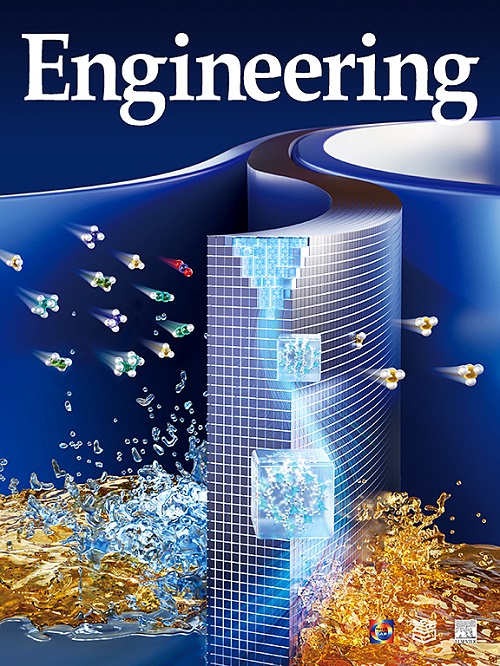肺泡 2 型细胞产生的 PAI-1 推动了与衰老相关的肺纤维化
IF 10.1
1区 工程技术
Q1 ENGINEERING, MULTIDISCIPLINARY
引用次数: 0
摘要
肺纤维化(PF)是一种主要影响老年人的致命性肺部疾病;然而,衰老是否以及如何引发肺纤维化仍不清楚。为了找出肺纤维化的主要诱发因素,我们首先分析了 45 名正常供体和 51 名肺纤维化患者肺组织的单细胞 RNA 测序(scRNA-seq)数据,发现衰老可能是肺纤维化形成的主要催化剂。为了进一步研究衰老对 PF 形成的影响,我们利用自然衰老小鼠模型进行了全面深入的研究。我们发现,在衰老诱导的 PF 进展过程中,胶原纤维数量和类型的动态变化,尤其是胶原蛋白(Col)I 的变化,成为 PF 的主要驱动因素。随后,我们利用原代肺泡 2 型(AT2)细胞和 A549 细胞系,通过条件培养基和 Transwell 共培养研究了衰老过程中 Col I 合成的调控,结果发现,衰老的 AT2 细胞分泌物,尤其是纤溶酶原激活物抑制剂(PAI)-1,通过转化生长因子(TGF)-β/小母体抗截瘫因子(Smad)2/3 途径,促进了纤维化并增强了 I 型α1(Col1al)胶原的生成。此外,scRNA-seq 和人类肺组织的组织学分析表明,在衰老的肺组织和 AT2 细胞中,SERPINE1(编码 PAI-1 的基因)和 PAI-1 的表达均显著上调,这与我们在动物实验中的发现一致,为 PAI-1 在衰老和 PF 的发展过程中的关键作用提供了更多证据。我们的研究表明,PAI-1 是衰老的 AT2 细胞分泌的一种关键因子,它在促进成纤维细胞中 Col1a1 的合成、随后导致 Col I 沉积以及通过介导 TGF-β/Smad2/3 通路推动 PF 进展方面发挥着关键作用。我们的研究结果为上皮功能障碍参与与年龄相关的 PF 提供了关键证据,并为临床干预提供了潜在的新治疗靶点。本文章由计算机程序翻译,如有差异,请以英文原文为准。
PAI-1 Derived from Alveolar Type 2 Cells Drives Aging-Associated Pulmonary Fibrosis
Pulmonary fibrosis (PF) is a lethal lung disease that predominantly affects older adults; however, whether and how aging triggers fibrosis remains unclear. To pinpoint the predominant initiating factors of PF, we first analyzed single-cell RNA sequencing (scRNA-seq) data from the lung tissues of 45 normal donors and 51 PF patients and found that aging might serve as the primary catalyst for PF development. To further investigate the influence of aging on PF formation, we conducted a comprehensive and thorough study employing a natural aging mouse model. We found that dynamic alterations in the quantity and types of collagen fibers during aging-induced PF progression, especially in collagenous (Col) I, emerged as the predominant driver of PF. We then investigated the regulation of Col I synthesis during aging using primary alveolar type 2 (AT2) cells and A549 cells line through conditioned media and Transwell coculture, and found that secretions—particularly plasminogen activator inhibitor (PAI)-1—from aged AT2 cells promoted fibrosis and enhanced collagen type I alpha 1 (Col1al) production via the transforming growth factor (TGF)-β/small mother against decapentaplegic (Smad)2/3 pathway. Furthermore, scRNA-seq and a histological analysis of human lung tissue demonstrated a significant upregulation of SERPINE1 (the gene encoding PAI-1) and PAI-1 expression in both aging lung tissue and AT2 cells, which was consistent with our findings from animal experiments, providing additional evidence for the pivotal role of PAI-1 during aging and the development of PF. Our research demonstrates that PAI-1, a crucial factor secreted by aging AT2 cells, exerts a pivotal role in promoting the synthesis of Col1a1 in fibroblasts, subsequently leading to Col I deposition, and in driving the progression of PF by mediating the TGF-β/Smad2/3 pathway. Our findings offer critical evidence for the involvement of epithelial dysfunction in age-related PF and provides potential novel therapeutic targets for clinical intervention.
求助全文
通过发布文献求助,成功后即可免费获取论文全文。
去求助
来源期刊

Engineering
Environmental Science-Environmental Engineering
自引率
1.60%
发文量
335
审稿时长
35 days
期刊介绍:
Engineering, an international open-access journal initiated by the Chinese Academy of Engineering (CAE) in 2015, serves as a distinguished platform for disseminating cutting-edge advancements in engineering R&D, sharing major research outputs, and highlighting key achievements worldwide. The journal's objectives encompass reporting progress in engineering science, fostering discussions on hot topics, addressing areas of interest, challenges, and prospects in engineering development, while considering human and environmental well-being and ethics in engineering. It aims to inspire breakthroughs and innovations with profound economic and social significance, propelling them to advanced international standards and transforming them into a new productive force. Ultimately, this endeavor seeks to bring about positive changes globally, benefit humanity, and shape a new future.
 求助内容:
求助内容: 应助结果提醒方式:
应助结果提醒方式:


